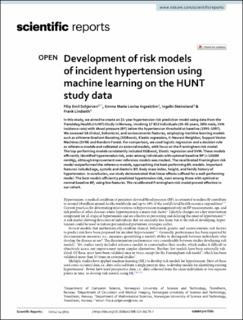| dc.description.abstract | In this study, we aimed to create an 11-year hypertension risk prediction model using data from the Trøndelag Health (HUNT) Study in Norway, involving 17 852 individuals (20–85 years; 38% male; 24% incidence rate) with blood pressure (BP) below the hypertension threshold at baseline (1995–1997). We assessed 18 clinical, behavioral, and socioeconomic features, employing machine learning models such as eXtreme Gradient Boosting (XGBoost), Elastic regression, K-Nearest Neighbor, Support Vector Machines (SVM) and Random Forest. For comparison, we used logistic regression and a decision rule as reference models and validated six external models, with focus on the Framingham risk model. The top-performing models consistently included XGBoost, Elastic regression and SVM. These models efficiently identified hypertension risk, even among individuals with optimal baseline BP (< 120/80 mmHg), although improvement over reference models was modest. The recalibrated Framingham risk model outperformed the reference models, approaching the best-performing ML models. Important features included age, systolic and diastolic BP, body mass index, height, and family history of hypertension. In conclusion, our study demonstrated that linear effects sufficed for a well-performing model. The best models efficiently predicted hypertension risk, even among those with optimal or normal baseline BP, using few features. The recalibrated Framingham risk model proved effective in our cohort. | en_US |

